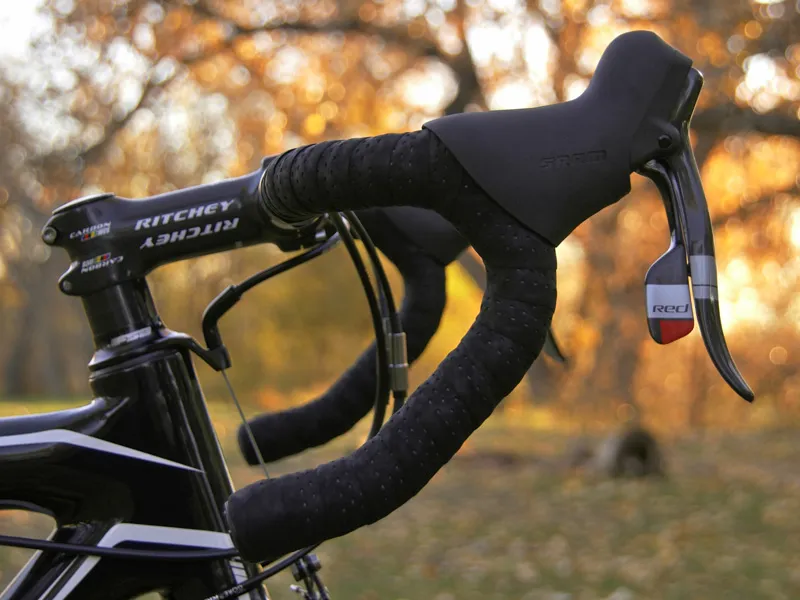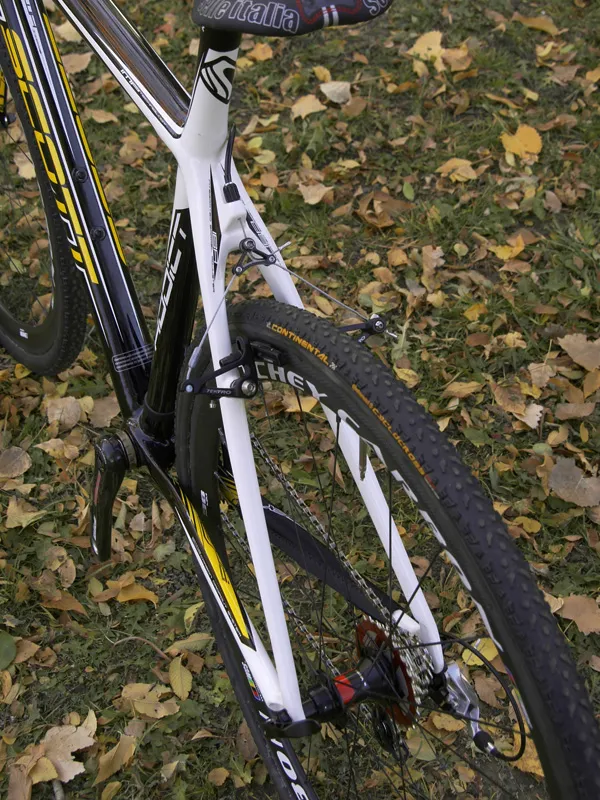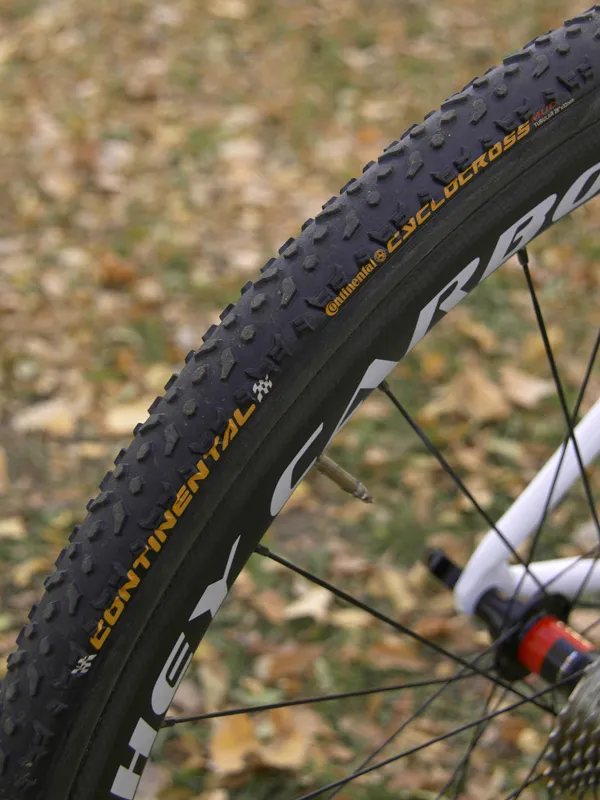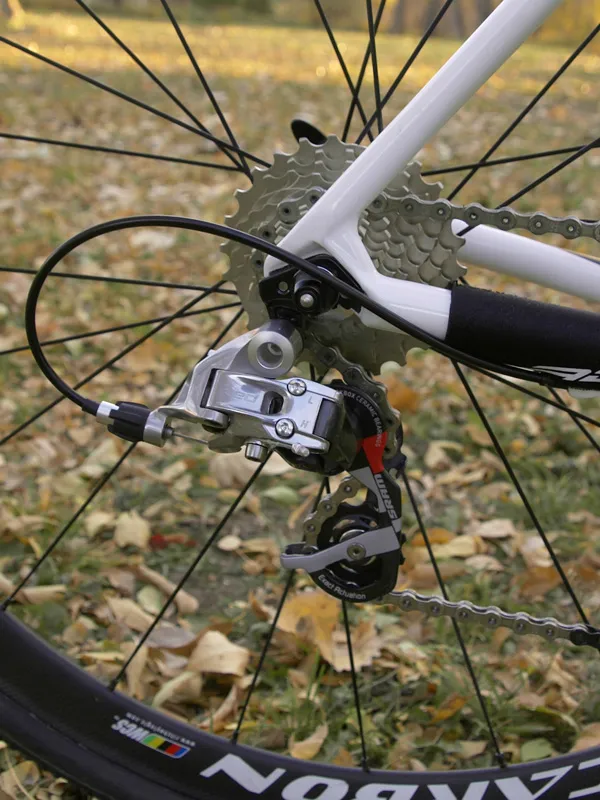Scott’s new Addict CX RC is a faithful ‘cross rendition of its flagship road rocket complete with all of the original’s carbon fibre technology and drool-worthy numbers. Though the geometry has been adjusted, the stays widened and the frame reinforced for the rigours of ‘cross, claimed frameset weight is still 980g – just 190g heavier than the road-going Addict LTD.
The Addict CX RC is an amazing rig for the dedicated ‘cross racer and it’s a virtual guarantee that you’ll go faster aboard one – and we don’t say that often. Save for a handful of relatively minor quibbles, it’s nearly everything we could dream of for a ‘cross racer and then some. If you have the money, buy one and never look at your current racer the same way ever again. Just do your best to keep it upright as neither the ultralight carbon parts nor the thin frame tube walls are likely to hold up well to impact.
Still, über-machine or not, £4,299.99 (US$7474.99) is an enormous sum of money for what will likely be someone’s second or third rig. Scott also sells the frameset for £2,005 (US$3299.99 - frame with integrated mast, fork, headset and seatpost head) or, for just another £445 (US$800), the standard Addict CX with a lesser parts spec and an extra kilo of heft. Seeing as how the chassis is the star of the show here, either of those options strike us as better value.

Ride & handling: Swift and nimble, but don't expect long-ride comfort
Much as we’ve come to expect from the road-going Addict, the Addict CX RC is a true ultralight yet noticeably more rigid than many frames that are far heavier. It’s easily the fastest ‘cross bike we’ve tossed a leg over. Acceleration from a standing start is road bike-quick and sizeable gaps close up with but a few hard pedal strokes. There isn't a hint of flex from the bottom end or front triangle regardless of how hard you try and you’re constantly reminded of how easy it is to muscle this sub-7kg steed up the short power climbs typical of ‘cross.
Handling is also spot-on. Compared with a similarly sized Addict, the CX RC has a slightly shorter top tube, longer chainstays and a slacker head angle that yields an appropriately nimble personality that never feels too quick or too floppy. The accompanying Ritchey WCS Carbon Cross fork helps here as well with beefy carbon blades that offer precise steering and chatter-free braking.
The CX RC’s modest 2mm of extra bottom bracket height yields a center of gravity that is barely taller than on the road. While this means you won’t be able to pedal through quite as many corners as on a more Euro-style ‘cross bike, the upside is more stable cornering so you can dive in faster and harder.
Though the Addict CX RC's thin-walled carbon construction delivers the usual damping of high-frequency buzz and fairly lively feel, there’s little compliance to soften impacts. If anything, the stouter wishbone-style seatstays offer even less vertical flex than on the standard Addict and cornering on rough ground can be skittish.

Low-pressure tubulars aside, the Addict CX RC is stiff with a capital ‘S’ and yet makes no apologies for its harsh nature. Don’t forget: this is a race bike through and through, and there’s little need for a cushy ride when the target arena is only an hour long. True, a softer frame might deliver you to the finish line feeling fresher – but maybe a few places back from someone of similar fitness who was on something lighter, stiffer and more responsive.
With such little weight, shouldering is less painful than usual, thanks in part to the oversized and slightly flattened top tube and mildly sloping frame geometry that still leaves enough room to easily reach your arm through. We were initially taken aback by the rear brake cable routing – which runs beneath the top tube – but the forward stop is mounted far enough towards the head tube that it doesn’t dig into your shoulder and the cable is at least offset a bit to the side.
According to Scott frontman Adrian Montgomery, this is the preferred routing or sponsored rider Thomas Frischknecht and the Scott-Swisspower team. That may be the case, but the cable ends up slightly between you and the top tube on run-ups and the five o’clock position results in a less-than-ideal housing kink at the seatstay wishbone. Twelve o’clock routing would move everything away from the shoulder and allow Scott to run the line directly through the integrated mast for the ultimate in low-friction routing.

Frame: Light as a feather, stout as a rock
Like the standard Addict, Scott uses its most advanced IMP (Integrated Molding Process) and CR1construction techniques plus its highest-grade HMX-NET carbon fibre in building the CX RC and just about everything on the ‘cross version is made exclusively of carbon fibre, including the dropouts and most of the housing stops. Aluminium inserts are used at the integrated rear brake housing stop, bottom bracket threads and front derailleur mount, though, and the rear derailleur hanger is a replaceable aluminium unit as well.
Total weight for our complete top-end Addict CX RC tester is a mind-blowing 6.72kg (14.8lb, size small) without pedals. Toss in a set of Crankbrothers Eggbeater 4Ti pedals and t’s still just barely UCI-legal – for a road bike.

Equipment: Top-shelf parts picks – just make sure you don't crash
£4,299.99 is a hell of a lot of money to ask for any ‘cross bike but the Addict CX RC includes a component spec that wants for little and goes a long way towards helping it hit that sultry weight figure.
The SRAM Red transmission continues to be one of our favorites for ‘cross thanks to its positive ‘shift, clunk’ shifting performance and the FSA SL-K Light crankset is wisely fitted with discipline-appropriate 46/36T chainrings. The matching 11-26T spread on the SRAM OG-1090 cassette still offers a fairly wide range of gears but the PowerDome design’s shallow channels are known to clog up in heavy mud – keep that in mind if course conditions are gloopy.
Speaking of mud, Scott clearly anticipates that the Addict CX RC will see plenty. The DT Swiss 240s hubs are laced with DT Swiss Aerolite spokes to 38mm-deep Ritchey WCS Carbon tubular rims that are not so valuable here for their aerodynamics but rather their ability to cut through muck and sand. Wrapped around those rims are Continental’s new 32mm-wide Cyclocross Mud tubulars with their aggressive open tread pattern and stopping the whole shebang is a set of wide-profile Tektro cantilevers.

Though this combination is undoubtedly excellent for tromping through the slop, it isn’t so great in dryer conditions. The knobby Continental tubulars roll surprisingly fast regardless of terrain and provide excellent bite on looser ground but are a bit sketchy in fast, hardpacked corners.
Likewise, the Tektro cantilevers deliver plenty of mud clearance and a firm lever feel but, like most wide-profile brakes, there’s little power when you need to scrub a lot of speed or are careening into a hard corner at the bottom of a technical descent. They’re also rather tightly sprung and the single mounting holes front and rear offer no alternatives for backing off the tension.
We can’t help but wonder about the long-term durability of the carbon railed Selle Italia saddle and Ritchey Logic II Carbon bar, too. Both bits undoubtedly shave precious grams but the latter is prone to damage from the inevitable crash and the former certainly had us paying more attention than usual during remounts. Neither failed during testing (which unfortunately also included crashing!) but potential buyers might want to consider swapping both items for something a little tougher.

















